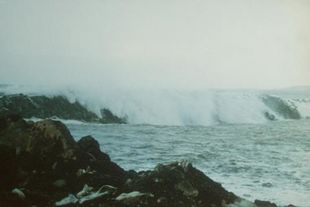Difference between revisions of "Wave overtopping"
Dronkers J (talk | contribs) |
Dronkers J (talk | contribs) |
||
| Line 2: | Line 2: | ||
{{ | {{ | ||
Definition|title= Wave overtopping | Definition|title= Wave overtopping | ||
| − | |definition= Wave overtopping | + | |definition= Wave overtopping refers to the average quantity of water that is discharged per linear meter by waves over a protection structure (e.g. breakwater, dike) whose crest is higher than the still water level (SWL). }} |
| Line 55: | Line 55: | ||
==Related articles== | ==Related articles== | ||
:[[Stability of rubble mound breakwaters and shore revetments]] | :[[Stability of rubble mound breakwaters and shore revetments]] | ||
| − | :[[ | + | :[[Wave transmission by low-crested breakwaters]] |
:[[Wave run-up]] | :[[Wave run-up]] | ||
:[[Overtopping resistant dikes]] | :[[Overtopping resistant dikes]] | ||
Revision as of 10:41, 17 May 2023
Definition of Wave overtopping:
Wave overtopping refers to the average quantity of water that is discharged per linear meter by waves over a protection structure (e.g. breakwater, dike) whose crest is higher than the still water level (SWL).
This is the common definition for Wave overtopping, other definitions can be discussed in the article
|

|

|
| Fig. 1a. Wave-overtopping of a breakwater in a flume test. | Fig. 1b. Wave-overtopping of a breakwater in nature. |
Notes
Pictures of wave overtopping in the laboratory and in the field are shown in Fig. 1; a schematic representation with definitions is displayed in Fig. 2. During overtopping, two important processes take place: wave run-up on the structure and partial transmission of waves. The process of wave overtopping is highly random in time, space and volume; there is no permanent discharge over the crest of a structure. The highest waves may wash a large volume of water over the crest in a short period of time (less than a wave period), whereas lower waves may not produce any overtopping.
An empirical formula for the average water discharge [math]q[/math] per linear meter by waves over a protection structure is given in the EurOtop manual[1]
[math]\Large\frac{q}{\sqrt{gH_{m0}^3}}\normalsize \equiv q^* = 0.09 \exp(-\large\frac{1.5 R_c}{\gamma_f H_{m0}}\normalsize) , \qquad (1)[/math]
for perpendicular wave incidence. Since observational overtopping rates of more than a factor 10 higher were observed in several experiments, a revised formula was developed by Eldrup et al. (2022[2]). The general form of the wave overtopping discharge is
[math]q^* = a \, \exp\Big[ \big(-b \large\frac{R_c}{H_{m0}}\normalsize \big)^c \Big], \qquad (2)[/math]
where the coefficients [math]a, b, c[/math] depend on (see Fig. 2):
- The spectral wave height at the toe of the structure [math]H_{m0}[/math] (approximately equal to the significant wave height [math]H_s[/math], see Statistical description of wave parameters)
- The spectral wave energy period [math]T_{m-1,0}[/math]
- The water depth [math]h_{toe}[/math] at the toe of the structure
- The breakwater wave run-up [math]R_2[/math] exceeded by only 2 % of the waves; [math]R_2/ H_{m0}[/math] depends on the roughness (and permeability) reduction factor [math]\gamma_f[/math], the surf similarity parameter [math]\xi[/math] and the wave obliqueness,
- The freeboard [math]R_c[/math] (the structure crest level relative to the still water level (SWL);
- The seabed slope [math]m[/math]
- The front slope of the structure [math]\tan \alpha[/math]
- The crest width of the structure [math]G_c[/math]
- The surf similarity parameter (Iribarren number) [math]\xi = T_{m-1,0} \tan \alpha \sqrt{\large\frac{g}{2 \pi H_{m0}}}[/math]
- The roughness (and permeability) reduction factor [math]\gamma_f[/math] that accounts for the roughness and percolation of structures’ slope. The reduction factor [math]\gamma_f[/math] may further depend on the surf similarity parameter and the overtopping flow rate. Usual values for rubble mound structures are in the range [math]\gamma_f \sim 0.4 – 0.6[/math].
Typical design values are in the range: [math]H_{m0} \sim[/math]2-5 m, [math]T_{m-1,0} \sim[/math]8-15 s, [math]h_{toe}/H_{m0} \sim [/math]1-4, [math]R_2/H_{m0} \sim [/math]2-6, [math]R_c/H_{m0} \sim [/math]1-3, [math]G_c/H_{m0} \sim [/math]1-3, [math]\tan \alpha \sim [/math]0.25-0.6, [math]m \sim[/math]0.005-0.05, [math]\xi \sim [/math]2-8.
A simpler formula for overtopping of rubble mound breakwaters by surging waves was empirically derived by Etemad-Shahidi et al. (2022[3]):
[math]q^* = (1.22 \pm 0.13) 10^{-4} \, \exp \big[ (3.5 \pm 0.13) \large\frac{R_2 -R_c}{H_{m0}}\normalsize – (0.64 \pm 0.07) \large\frac{G_c}{H_{m0}}\normalsize \big] . \qquad (3)[/math]
The standard deviation of observational data with respect to this formula is about a factor 3. This uncertainty is mainly related to estimating the wave run-up. The EurOtop manual[1] proposes for approximately normal wave incidence:
[math]R_2 = 1.65 \, \gamma_f \, H_{m0} \, \xi \;[/math], with a maximum of [math]\gamma_{sf} \, H_{m0} \, (4 - 1.5 \, \xi^{-1/2})[/math]. The friction factor [math]\gamma_{sf}[/math] for surging waves is estimated as [math]\gamma_{sf} = \gamma_f + 0.12 \, (1-\gamma_f)(\xi-1.8)[/math] with a minimum value equal to [math]\gamma_f[/math].
The formulas (1,3) overpredict the wave overtopping for very shallow foreshores where [math]h_{toe}/H_{m0} \lt 0.5[/math] [4].
Related articles
- Stability of rubble mound breakwaters and shore revetments
- Wave transmission by low-crested breakwaters
- Wave run-up
- Overtopping resistant dikes
- Detached breakwaters
- Modelling coastal hydrodynamics
References
- ↑ 1.0 1.1 EurOtop, 2018. Manual on wave overtopping of sea defences and related structures. An overtopping manual largely based on European research, but for worldwide application. Van der Meer, J.W., Allsop, N.W.H., Bruce, T., De Rouck, J., Kortenhaus, A., Pullen, T., Schüttrumpf, H., Troch, P. and Zanuttigh, B., www.overtopping-manual.com
- ↑ Eldrup, M.R., Andersen, T.L., Van Doorslaer, K. and Van der Meer, J. 2022. Improved guidance on roughness and crest width in overtopping of rubble mound structures along EurOtop. Coastal Engineering 176, 104152
- ↑ Etemad-Shahidi, A., Koosheh, A. and Van Gent, M.R.A. 2022. On the mean overtopping rate of rubble mound structures. Coastal Engineering 177, 104150
- ↑ Tarakcioglu, G.O., Kisacik, D., Gruwez, V. and Troch, P. 2023. Wave Overtopping at Sea Dikes on Shallow Foreshores: A Review, an Evaluation, and Remaining Challenges. J. Mar. Sci. Eng. 11, 638
Please note that others may also have edited the contents of this article.
|
